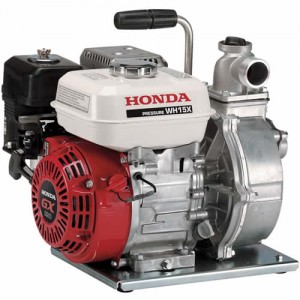 The Honda WH15X water pump is light enough to carry anywhere requiring drainage, but it’s still a fairly complex machine despite its small size. Getting the most from it is a matter of understanding how to use it from setup to shut down.
The Honda WH15X water pump is light enough to carry anywhere requiring drainage, but it’s still a fairly complex machine despite its small size. Getting the most from it is a matter of understanding how to use it from setup to shut down.
Pump Safety
The WH15X is designed only for pumping fresh water that is not intended for human consumption. Pumping flammable liquids like gasoline could result in a fire or explosion, while pumping sea water, chemical solutions and other non-water fluids can cause corrosion, damaging the pump.
If the operator needs to leave the pump for any reason, the pump should be shut off. Learn all the pump’s functions, and in particular how to perform an emergency stop, before using it. Children and pets should be kept away from the pump.
Refueling should only be done outside with the pump on a level surface and the engine off.
The muffler can remain hot long after the engine has been shut down. Let it cool for several minutes before moving the pump or storing it indoors.
The WH15X should be operated outside at least three feet (one meter) away from building walls and other equipment to reduce the possibility of fire and carbon monoxide poisoning from the exhaust.
This pump can create sparks that could start fires around dry grass and other vegetation. A spark arrestor is available for this pump, and may be legally required for operation in some areas.
Where is Everything?
Facing the engine side, the choke lever is to the left of the starter cover and the fuel valve directly below that. The throttle lever is above and to the left of the starter housing. The ignition switch is to the upper right of the cover.
Facing the pump side, the suction port is at the center of the pump housing, and the pump drain plug is directly below it. The discharge port is on top of the housing, while the priming water cap is just behind this opening. The oil filler cap can be found behind the housing on the left side and the drain plug on the opposite side.
Looking at the top, the fuel tank is to the right of the handle and the muffler is to the left. The air filter is on the lower left.
Before Operation
Check the exterior of the pump and motor for signs of oil or gas leaks and remove any dirt or debris. Make sure all nuts, bolts, screws and hose connectors are tight.
Inspect the hoses and the sealing gasket on the suction hose for any signs of damage. Use a suction hose that is reinforced to prevent collapse and make sure the strainer has been installed to prevent debris from reaching the pump.
Check the engine oil level, air filter and fuel tank.
Pump and Hose Placement
The pump should be placed as close to water level as possible, and hoses should be as short as possible for optimum output and shorter self-priming time. Using larger diameter hoses will decrease fluid friction, further improving performance.
When pumping water upward, the discharge hose should make up more of the height change than the suction hose since it requires less power to move water out of the pump than into it.
Operation
The WH15X needs to be primed with water before starting: running it without water can cause heat buildup that can destroy the pump seal. If the pump is accidentally run before priming, shut off the engine and let the pump cool completely before priming and starting the motor. To prime the pump, open the filler cap next to the discharge hose outlet, fill the chamber with water, and then refit the cap.
To start the engine, move the fuel valve to the “On” position. If the engine is cold, move the choke lever clockwise to the “Closed” position. Move the throttle lever so that it is 1/3 of the distance from “Slow.” Turn the ignition switch to the “On” position. Pull the starter grip gently until some resistance is felt, then pull hard to turn over the engine. Once the engine is running, gently return the handle, letting the starter pulley draw in the cable. Move the throttle clockwise to the “Fast” position to prime the suction line. Once the pump is drawing water, adjust the throttle position to change the pumping rate. Gradually open the choke as the engine warms up.
The engine can be stopped immediately in the event of an emergency by turning the ignition switch to “Off.” Under normal conditions, the engine should be shut off by moving the throttle to the “Slow” position, turning the ignition switch to “Off” and turning the fuel valve lever to “Off.” Remove the pump drain plug located at the bottom back of the pump and flush the pump chamber with clean water by pouring it through the priming chamber. Let the pump drain completely before reinstalling the drain plug and priming chamber cap.
Where Can I Buy Parts for My Water Pump?
Need a new set of hoses or a spark arrestor to meet local fire codes? www.hondalawnparts.com is a full line dealer of OEM Honda small engine parts including water pumps.
